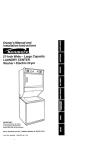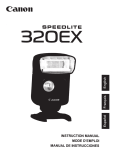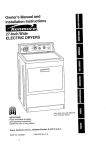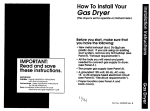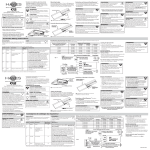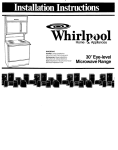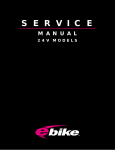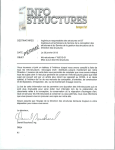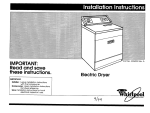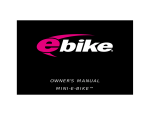Download SUBURBAN GAS FURNACES
Transcript
ms uburban S U B U R B A N M A N U F A C T U R I N G COMPANY P o s t O f f i c e B o x 399 Dayton, T e n n e s s e e 37321 Manufacturing Company SUBURBAN GAS FURNACES CERTIFIED INSTALLATION INSTRUCTIONS FOR MODELS SF-20 SF-25 SF-30 SF-35 The design of the furnace has been listed for installation i n recreational vehicles only. In order for the furnace to operate in conformity with generally accepted safety regulations, the installation instructions must be followed. Failure t o comply with the installation instructions will void the warrantyon the furnaceand any responsibility on the part of Suburban Manufacturing Company. The furnace was inspected before i t left the factory. If any parts are found to be damaged, do not install the furnace. Immediately contact the transportation company and file a claim. FOR YOUR SAFETY FOR YOUR SAFETY WHAT TO DO IF YOU SMELL GAS: Extinguish any open flame. Evacuate all persons from the vehicle. Shut off the gas supply at the gas container or source. Do not touch any electrical switch, or use any phone or radio in the vehicle. Do not start the vehicle's engine or electric generator. Contact the nearest gas supplier or qualified service technician for repairs. If you cannot reach a gas supplier or qualified service technician, contact the nearest fire department. Do not turn on the gas supply until the gas leak(s) has been repaired. DO NOT STORE OR USE GASOLINE OR OTHER FLAMMABLE VAPORS AND LIQUIDS IN THE VICINITY OF THIS OR ANY OTHER APPLIANCE. WARNING! Improper installation, adjustment, alteration, service or maintenance can cause property damage, personal injury or loss of life. Refer to the installation instructions andlor owners manual provided with this appliance. Installation and service must be performed by a qualified installer, service agency or the gas supplier. This book contains instructions covering the operation and maintenance of your furnace. Keep with unit at all times. Should you require further information, contact your dealer or nearest Suburban Service Center. INSTALLATION INSTRUCTIONS WARNING! Installation ofthis appliance must bemadein accordance with the written instructions provided i n this manual. No agent, representative or employee of Suburban or other person has the authority t o change, modify or waive any provision of the instructions contained i n this manual. CAUTION: This furnace was shipped from the factory set up for the gas connection to be made at the right rear of the unit as illustrated i n Figure I. If you wish t o make gas connection through the top of cabinet, you must remove furnace from cabinet and turn gas inlet fitting 90" CLOCKWISE. DO NOT TURN FITTING COUNTER-CLOCKWISE, this will loosen fitting and result i n a gas leak. These furnaces are designed and installed in such a manner as to be removable only from the exterior of the recreational vehicle. CAUTION: If possible, do not install the furnace t o where the vent can be covered or obstructed when any door on the trailer is opened. If this i s not possible, then the travel of the door must be restricted i n order t o provide a 6" minimum clearance between the furnace vent and any door whenever the door is opened. NOTE: The exhaust of this furnace could discolor or warp some materials. you should verify that the material used on the coach door, panel, or cover will not discolor or warp from the temperaturewhenever any door, panel, or cover is in the open position. . CAUTION: Due t o the differences i n vinyl siding, this appliance should not be installed on vinyl siding without first consulting with the manufacturer of the siding or cutting the siding away from the area around the appliance vent. CAUTION: In any installation in which the vent of this appliance can be covered due t o the construction of the RV or some special feature of the RV such as slide out, pop-up etc. always insure that the appliance cannot be operated by setting the thermostat to the positive position and shutting off all electrical and gas supply to the appliance. Never operate furnace with vent covered. Form No. 2549-C NOTE. These furnaces must be installed and vented as described in this manual that Ihe negative pressure created by the air circulating (return air) fan cannot affect the combustion air intake or venting of any other appliance. IIis imperative that the products of combustion be properly vented to the atmosphere and that all combustion air supplled to burner be drawn from the outside atmosphere. (See Installing Vent Assembly.) SO NOTE: Do not Install the furnace with the vent facing toward the forward end of the coach. IMPORTANT: If this furnace is to be connected to a common duct system also sewing a cooling unit, a manual or automatic damper is required to prevent any cold conditioned air from circulating back into the furnace. Cold air passing over the furnace combustion chamber during theoperation ofthecooling unit can result in the formation of condensation inside the furnace combustion chamber. This condensation may promote corrosion and premature failure of the combustion chamber. SUBURBAN MANUFACTURING COMPANY Post Office Box 399 Dayton, Tennessee 37321 SUBURBAN GAS FURNACES CERTIFIED INSTALLATION INSTRUCTIONS FOR MODELS SF-20 SF-25 SF-30 SF-35 The design of the furnace has been listed for installation i n recreational vehicles only. In order for the furnace to operate i n conformity with generally accepted safety regulations, the installation instructions must be followed. Failure to comply with the installation instructions will void the warranty on the furnaceand any responsibility on the part of Suburban Manufacturing Company. The furnace was inspected before i t left the factory. If any parts are found to be damaged, do not install the furnace. Immediately contact the transportation comnanv and file a claim. FOR YOUR SAFETY FOR YOUR SAFETY WHAT TO DO IF YOU SMELL GAS: Extinguish any open flame. Evacuate all persons from the vehicle. Shut off the gas supply at the gas container or source. Do not touch any electrical switch, or use any phone or radio in the vehicle. Do not start the vehicle's engine or electric generator. Contact the nearest gas si~pplier or qualified service technician for repairs. If you cannot reach a gas supplier or qualified service technician, contact the nearest fire department. Do not turn on the gas supply until the gas leak(s) has been repaired. DO NOT STORE OR USE GASOLINE OR OTHER FLAMMABLE VAPORS AND LIQUIDS IN THE VICINITY OF THIS OR ANY OTHER APPLIANCE. WARNING! Improper installation, adjustment, alteration, service or maintenance can cause property damage, personal injury or loss of life. Refer to the installation instructions andlor owners manual provided with this appliance. Installation and service must be performed by a qualified installer, service agency or the gas supplier. This book contains instructions covering the operation and maintenance of your furnace. Keep with unit at all times. Should you require further information, contact your dealer or nearest Suburban Service Center. 1 WARNING! Be sure the furnace and all ignition systems are "OFF" during any type of refueling and while vehicle is in motion or being towed. INSTALLATION INSTRUCTIONS WARNING! Installation ofthis appliance must bemade in accordancewith the written instructions provided i n this manual. No agent, representative or employee o f Suburban or other person has the authority t o change, modify or waive any provision of the instructions contained i n this manual. These furnaces are designed and installed in such a manner as to be removable on!y from the exterior of the recreat~onalvehicle. CAUTION: If possible, do not install the furnace to where the vent can be covered or obstructed when any door on the trailer is opened. If this is not possible, then the travel of the door must be restricted i n order to provide a 6" minimum clearance between the furnace vent and any door whenever the door i s opened. NOTE: The exhaust temperature of this furnace could discolor or warp some materials. You should verify that the mater~alused on the coach door, panel, or cover will not discolor or warp from the exhaust temperature whenever any door, panel, or cover is in the open position. . CAUTION: Due t o the differences i n vinyl siding, this appliance should not be installed on vinyl siding without first consulting with the manufacturer of the siding or cutting the siding away from the area around the appliance vent. CAUTION: In any installation i n which the vent of this appliance can be covered due to the construction of the RV or some special feature of the RV such as slide out, pop-up etc. always insure that the appliance cannot be operated by setting the thermostat to the positive "OFF" position and shutting off all electrical and gas supply t o the appliance. Never operate furnace with vent covered. Form No. 2549-C CAUTION: This furnace was shipped from the factory set up for the gas connection to be made at the right rear of the unit as illustrated in Figure I. If you wish to make gas connection through the top of cabinet, you must remove furnace from cabinet and turn gas inlet fitting 90' CLOCKWISE. DO NOT TURN FITTING COUNTER-CLOCKWISE, this will loosen fitting and result in a gas leak. from being inserted on the valve and to prevent any leaks from developing. Be sure to check all fittings for leaks including the inlet and outlet on the valve before reinstalling furnace into cabinet Correct all leaks immediately. NOTE: The furnace must be in operation to properly NOTE: These furnaces must be installed and vented as described in this manual so that the negative pressure created by the air circulating (return air) fan cannot affect the combustion air intake or venting of any other appliance It is imperative that the products of combust~onbe properly vented to the atmosphere and that all combustion alr supplied to burner be drawn from the outside atmosphere. (See Installing Vent Assembly.) NOTE: Do not install the furnace with the vent facing toward the fofward end of the coach. IMPORTANT: If this furnace is to be connected to a common duct system also serving a cooling unit, a manual or automatic damper is required to prevent any cold conditioned air from circulating back into the furnace. Cold air passing over the furnace combustion chamber during theoperation of the cooling unit can result in the formation of condensation inside the furnace combustion chamber. This condensation may promote corrosion and premature failure of the combustion chamber. NOTE: These furnaces shall be installed so the electrical components are protected from water. These furnaces are design certified for propane1LP gas only. Do not attempt to convert to natural gas. Gas supply pressure for purposes of input adjustment: Max~mum- 1 3 W.C ' Minimum - 11" W.C.' (W.C - Water Column). In the U.S.A.. the installation of the furnace must be in accordance w~thlocal codes and regulations. In the absence of local codes and regulations. refer to the latest edition of: I.Standard for Recreational Vehicles ANSl A-1 19.2lNFPA 501C. 2. National Fuel Gas Code ANSl 2223.1 3. Furnace must be electrically grounded in accordance w ~ t hthe latest edition of the National Electrical Code ANSllNFPA No. 70. In Canada, the furnace must be installed in accordance with: I.Standard CANICSA-2240 Recreational Vehicles. 2. CSA Standard CANICSA-2240.6.2-M86 Electrical Recreational Vehicles. Requirements for 3. When an appliance is installed d~rectlyon carpet~ng,tile or other combustible material. other than wood flooring. the appliance shall be Installed on a metal or wood panel extending the full width and depth of the appliance If preferred, the carpeting, tile or combustible materials, other than wood may be cut away the full length and depth of the appliance plus the appliance minimum clearances to combustible. (See Table 2.) 4. Locate center lines for exhaust and intake tubes as shown in Figure 1. 5. Cut two 2-314" diameter holes through the removable wall section. (See Figure 2.) 6 . Put furnace in place, making sure that rear of furnace cabinet 1s as close to inner wall section of the coach as posslble and still assure proper vent tube overlap. (See Installing Vent Assembly.) 7. Using the two #10 x 314 sta~nlessscrews provided, fasten furnace cabinet to floor of coach through the holes provided in the furnace cabinet (See Figure 4.) 8. Be sure furnace is secured within furnace cabinet (See F~gure4.) 9. Install vent assembly. (See instructions for installing vent ) C. INSTALLATION USING THE FURNACE ACCESS DOOR SUPPLIED BY SUBURBAN (See Fiqure 4) ) Maximum wall thickness for this type installation i s 2". 3. Standard CANICSA-2240.4.2-M86 Installation Requirements for Propane Appliances and Equipment in Recreational Vehicles. 1. Locate the furnace near lengthwise center of coach. 4. CANICGA-El49 Installation Codes. 2. Choose a location for installation out of the way of wires, plpes, etc., which might interfere with the installation. Adhere to the minimum clearances from the cabinet to combustible construction as listed in Table 2. Refer to Figure 3 for illustration of furnace clearances. 5. Any applicable local codes and regulations. This unit is equipped with an electric igniter device that has an energy consumptionof .1 amp @ 12 volts D.C. WARNING! Extension tubes cannot be used. If you try to extend the vent, it will result i n improper installation which could cause unsafe furnace operation. Thereare three (3) methods described below for installing the furnace. Regardless of the method you choose, we require an opening be provided in the exterior of the trailer or motor home for free, unobstructed removal of the furnace. This exterior, removable panel or wall section of the trailer or motor home must be a minimum of 17-314 x 8. 3. When an appliance is installed directly on carpeting, tile or other combustible material, other than wood flooring, the appliance shall be installed on a metal or wood panel extending the full width and depth of the appliance. If preferred, the carpeting, tile or combustible maters, other than wood may be cut away the full length and depth of the appliance plus the appliance minimum clearances to combustibles. (See Table 2 ) 4. After furnace location has been determined, cut an opening 18-7/32 x 8-9/32" through the inner coach wall and the outer wall (skin) of the coach. 5. Caulk around opening as illustrated. Apply generously. The purpose of the caulking is to seal the back side of the door frame and the coach skin water tight. It is important that adequate return air be provided to assure normal heating and operation of the furnace. Failure to provide the minimum return air will cause erratic furnace cycling. Refer to the chart shown below for minimum return air requirements. 6. Secure frame to outer wall (skin) through the holes in the frame. Screws should be used. (See Figure 4.) NOTE: Do not place screws into the holes required for mounting the door. Return Air Requirements 7. Slide furnace in place. The back of the furnace should be installed against or as close as possible to the flange on the door frame. (See illustration.) The furnace must maintain 112" overlap on the intake and 1.114" overlap on the exhaust. Model Minimum Free (unobstructed) Area SF-20/25/30/35 55 Sq. In. TABLE I 8. Using the two # I 0 x 314 stainless screws provided, fasten furnace cabinet to floor of coach through the holes provided in the furnace cabinet. (See Figure 4.) 9. Be sure furnace is secured within furnace cabinet. (See Figure 4.) NOTE: Return air must be from within the living area of the coach. A. INSTALLATION DIRECTLY AGAINST OUTER PANEL OF COACH (See Figure I ) (Panel supplied by installer) Maximum wall thickness for this type installation i s 2". 1. Locate the furnace near lengthwise center of the coach. 2. Choose a location for installation out of the way of wires, pipes, etc.. which might interfere with the installation. Adhere to the minimum clearances from the cabinet to combustible construction as listed in Table 2. Refer to Figure 3 for illustration of furnace clearances. 10. Position furnace access door over the frame. Secure the door to the coach skin. Be sure the coach skin is of sufficient strength to keep furnace access door in place and insure a tight seal. It may be necessary to build a wood or metal frame around the opening in order to provide adequate strength for securing door. CAUTION: The screws provided with the door may not be o f sufticient length and size for all applications and i t may be necessary for the installer to substitute screws i n order to adequately secure the furnace access door. 11. Install vent assembly. (See instructions for installing vent.) Model 3. When an appliance is installed directly on carpetlnq, tile or other combustible material, other than wood flooring, the applianceshalrbe installed on a metal or wood panel extending the full width and depth of the appliance. If preferred, the carpeting, tile or combustible materials, other than wood may be cut away the full length and depth of the appliance plus the appliance minimum clearances to combustibles. (See Table 2.) Front Left Side Right Side Top Bottom Back Exhaust and Intake Tube 4. Cut an opening through the inner wall. This will allow the rear of the furnace to be installed against the outer panel of the coach. 5. Locate center lines for exhaust and intake, as shown in Figure 1 -NOTE- 6. Cut two 2-114" diameter holes through the outer panel of the coach. (See Figure 1.) 7. Put furnace in place. making sure that rear of the furnace cabinet is as close to outer panel of the coach as possible and still assure proper vent tube overlap. (See Installing Vent Assembly.) 8. Using the two # l o x 314 stainless screws provided, fasten furnace cabinet to floor of coach through the holes provided in the furnace cabinet. (See Figure 4.) 9. Be sure furnace is secured within furnace cabinet. (See Figure 4.) 10. Install vent assembly. (See instructions for installing vent.) B. INSTALLATION FLUSH WITH INNER WALL OF COACH (See Figure 2) (Exterior panel supplied by installer) Maximum wall thickness for this type installation is 2". I.Locate the furnace near lengthwise center of the coach. 2. Choose a location for installation out of the way of wires, pipes, etc, which might interfere with the installation. Adhere to the minimum clearances from cabinet to combustible construction as listed in Table 2. Refer to Figure 3 for illustration of furnace clearances. 0" MEANS TO SPACER BUMPS I CLEARANCE FROM DUCTS TO COMBUSTIBLE MATERIAL 114" (See Fiaure 3\r * TABLE 2 - I INSTALLING VENT ASSEMBLY The vent outlet must be installed so it is in the same atmospheric pressure zone as the combustion air intake. The exhaust and intake tubes must be installed from the outside, pass through the RV skin and slide onto the furnace exhaust and intake. WARNING! Do notalter the vent assembly supplied with this furnace. Any modifications will result inimproper installation whichcould causeunsafe furnace operation. CAUTION! Combustion air must not be drawn from the living area. All air for combustion must be drawn from the outside atmosphere. All exhaust gases must be vented to the outside atmosphere - never inside the RV. Therefore, i t is essential to insure that the vent cap and tube assemblies are properly installed. 1. Apply caulking to RV skin behind vent capas shown in ~ig'ure1 Apply caulking generously around perimeter of vent cap and across center as shown 2. Insert Intake tube through RV ski11and slide it onto the furnace intake (See Figure 2 ) Minimum tube overlap of 112" is requlred 3. Insert vent cap exhaust tube through RV skin and slide it onto the furnace exhaust (See Figure 2 ) Minimum tube overlap of 1 114" is required 4. Attach vent cap assembly to outer sldn of RV wilh the six (6) screws provided Do not install vent assembly upside down The words "Suburban" and "Dayton. Tenn." must be right side up. CONNECTING GAS SUPPLY Connect the gas supply to the furnace at the manifold, following the suggestions outlined below. It will be necessary10 hold the flare fitting on the furnace manifold when connecting or loosening gas line NOTE The compound used on threaded joints must be resistant to liquefied petroleum (LP) gas. NOTE. The appliance must be disconnected from the gas supply piping system during any pressure testing of that system at test pressure in excess of 112 PSIG. The appliance must be isolated from the gas supply piping during any pressure testing of the gas supply piping system at test pressure equal to or less than 112 PSIG. 1. A 318" male flare connection is provided for gas line hookup. Some standards may require the use of a manual shut off valve in the gas line external to the furnace cabinet. 2. In order to maintain a check ofgas supplied pressure to the furnace, Suburban advises the installer to provide the 118 NPT plug tap for test gauge connection immediately upstream of the gas supply connection to the furnace and that it be readily accessible. 3. After the furnace has been connected to the gas supply, all jo~ntsmust be checked for leaks. WARNING! Never check for leaks with an open flame. Turn on the gas and apply soapy water to all joints to see if bubbles are formed. CONNECTING ELECTRICAL SUPPLY , CAUTION: This furnace i s designed for negative ground 12 volt D.C. system only. Do not attempt to alter the furnace for a positive ground system o r connect the furnace directly to 115 volts A.C. Damage to furnace component parts will occur. Be sure all wiring to the furnace is of heavy enough gauge to keep the voltage drop through it to a minimum and to provide enough power for start-up surge. No 1'2 gauge wire is recommended. If any of the original wire that is supplied with the appliance must be replaced, it must be replaced with type 105" C or its equivalent. Power supply connections are to be on the right side of the furnace. The wires are color coded, red for positive (+) and yellow for negative (-). This polarity must be observed so the furnace motor will run the proper direction of rotation to insure correct air delivery. (See wiring diagram.) If the furnace power supply is to be from a converter, we recommend that the converter system used to power the furnace be wired in parallel with the battery. This will serve two purposes: 1. Provide a constant voltage supply to the furnace. 2. Filter any A.C. spikes or volt surges. CONNECTING DUCTS TO FURNACE The following duct requirements must be followed in order to assure proper operation of the furnace: A. The minimum open duct areas listed below must be maintained throughout entire duct system including through register: C. Avoid making any sharp turns in the duct system Sharp turns will increase the static pressure in the plenum area and could cause the furnace to cycle. D. Avoid making a lot of turns in the duct system. The straighter the duct system, the better the performance of the furnace. E. Maintain a minimum of 114" clearance where ducts pass through any combustible construction, such as coach cabinetry. (See Figure 3 ) NOTE: UL llsted duct materials can be 0 clearance. F. Do not install air boosters in the duct system Such devices wlll cause the furnace lo cycle on limit and to have erratic sail switch operation NOTE After installation of the furnace and duct system is completed, adjustments must be made to obtain a temperature rise within the range specified on the Rating Plate INSTALLING THERMOSTAT Locate the room thermostat approximately 4-112 feet above the floor on an inside bulkhead where it is not affected by heat from any source except room air. Connect thermostat wiring to the blue wires on right s ~ d eof furnace. (See wiring diagram ) PREVENTIVE MAINTENANCE WARNING! If the user of this appliance fails to maintain it i n the condition i n which it was shipped from the factory or if the appliance is not used solely for its intended purpose or if appliance is not maintained in accordance with the instructions in this manual, then the risk of a fire andlor the production of carbon monoxide exists which can cause CAUTION: Label all wires before disconnecting forservicing. Proper polarity must be observed so the furnace motor will run with the proper direction of rotation to insure correct air delivery. (See wiring diagram). CAUTION: Label all wires prior to disconnection when servicing controls. Wiring error can cause improper and dangerous furnace operation. Always verify proper operation of furnace after servicing. Your furnace should be inspected by a qualified service agency yearly before turning the furnace on. Particular attention should be given to the following Items. 1. lnspect furnace installation and vent termination to be sure furnace is properly secured in place (see Installation Instructions), that vent terminates to the atmosphere, and that vent tubes overlap properly (see Installing Vent Assembly.) 2. lnspect chamber and venting to assure that these components are physically sound wlthout holes or excessive corrosion and that the installation and/or reinstallation is In accordance with Suburban's installation instructions. (Reference installation manual supplied with furnace.) WARNING! It is imperative that the products of combustion be properly vented to atmosphere and that all combustion air supplied to burner be drawn from outside atmosphere. 3. Check the base on which furnace is mounted. Be sure it is physically sound. void of any sagging, deterioration, etc. 4. lnspect furnace, the venting, ducting and gas piping lo furnace for obvious slgns of deterioration. Correct any defects at once. 5. lnspect combustion chamber for restrictions in exhaust or intake. It is imperal~vethat the flow of intake combustion air and the flow of exhaust gases being expelled to the outside atmosphere not be obstructed. Any soot or loose debr~sshould be blown out using compressed air. (See Figure 7.) 6 . lnspect all gaskets. If any gaskets show signs of leakage or deterioration. replace them. Safe operation of Ihe furnace depends on all gaskets being tight. 7. lnspect return air inlet openings to the furnace. Remove any restrictions to assure adequate air flow. You, as the ownerluser, should inspect the furnace monthly during the heating season for presence of soot on vent. Operating the furnace under this condition could lead to serious property damage, personal injury or loss of life. If soot is observed on the vent, immediately shut the furnace down and contact a qualified service agency. Listed below are several safety related items that you should follow during the heating season to assure continued safe operation of the furnace. 1. lnspect furnace venting. Venting must be free of obstructions, void of soot, and properly terminated to the atmosphere. (See Installing Vent Assembly.) WARNING! Do not install screens over the vent for any reason. Screens will become restricted and cause unsafe furnace operation. Accessories are being marketed for RV products which we do not recommend. For your safety, only factory authorized parts are to be used on your furnace. NOTE: Ducts terminating i n a dead air space (like holding tank compartments) with n o means for return air recirculation should not be counted in the required duct area. Also ducts 2" in diameter o r smaller should not be counted i n the required duct area. . 6.Make the duct connections at the furnace cabinet tight. Loose connect~onswill result in overheating of the component parts on the furnace and a reduction of the heated air flow through the duct system. 2. Periodically inspect the vent for obstructions or presence of soot. Soot is formed whenever combustion is incomplete. This is your visual warning that the furnace is operating in an unsafe manner. If soot is present, immediately shut furnace down and contact your dealer or a qualified service person. 3. Keep furnace clean. More frequent cleaning may be required due to excessive lint from carpeting, bedding material, etc. It is imperative that control compartments, burners and circulating air passageways of the appliance be kept clean. 4. The motor is permanently lubricated and requires no oiling 5. Keep the furnace area clear of any combust~blematerials, gasollne or other flammable vapor and I~qu~ds. 8. Remove gas llne 6 Before operating furnace check the locat~on of the furnace vent to make sure ~twill not be blocked by the openlng of any door on the trader If ~tcan be blocked do not operate the furnace w ~ t hthe door open TO REINSTALL 7 Do not restrlct the flow of combust~onalr or the warm alr clrculat~onto the furnace To do so could cause personal Injury andlor death 2. Connect gas Ilne. 8 Never operate the furnace ~fyou smell gas Do not assume that the smell of gas ~n your RV 1s normal Any tlme you detect the odor of gas ~t 1s to be cons~deredllfe threatening and corrected lmmedlately Ext~ngulshany open flames ~nclud~ng cigarettes and evacuate all persons from the veh~cleShut off gas supply at LP gas bottle (See safety notlce on front cover of th~smanual ) 9 lmmed~atelyshut furnace down and call a servlce agency ~ffurnace cycles erratically or delays on lqnltlon WARNING! Should overheating occur, or the gas supply fail to shut off, shut off the manual gas valve to the appliance before shutting off the electrical supply. 10. Never attempt to repalr damaged parts. Always have them replaced by a qualified service agency 11. Never attempt to repalr the furnace yourself Seek the help of a qualified service person. 12. Never restrict the ducting installed by your tra~lermanufacturer. Todoso could cause improper furnace operation 13. Do not install air boosters in the duct system. Such devices will cause the furnace to cycle and to have errat~csail switch operat~on. 9. Remove t~e-downscrew at blower base and remove furnace from cabinet I . Slide u n ~lnto t cabinet and secure w ~ t hscrew at base of blower. 3. Check gas connections for leaks using a soap and water solution. Correct any gas leaks immed~ately 4. Reinstall module board and panel assembly 5. Reconnect electrode wire to board 6. Reconnect power supply to board. 7. Reconnect power to furnace. NOTE If thls connection was made inside the cabinet, care must be exercised to prevent wires from coming In contact with the room alr blower wheel 8. Reinstall optional back. 9. Reinstall vent cap. 10. Provlde power to furnace. OPERATING INSTRUCTIONS WARNING! Do not operate furnace while vehicle is in motion or being towed. NOTE: During initial firing of this furnace, a burn-off of excess paint and oils remaining from manufacturing process may cause 'smoking" for 5 - 10 minutes. 1. Stop! Read Users Information Manual supplied w~thfurnace. 14. Clothing or other flammable materlal should not be placed on or near the appliance 2. Turn the manual valve (if so equipped) or the valve at the outside LP tank to the "OFF" position. Do not force. 15. Always follow the operat~nginstructions. Do not deviate from the step-by-step procedures. 3. Set thermostat above room temperature to begin blower operation A slight delay will occur before the blower comes on. Allow blower to run for 5 minutes for combustion chamber purge cycle. 16. Do not use this appl~anceif any part has been submerged under water. Immediately call a quallfled service technician to inspect the appliance and to replace any part of the control system and any gas control that has been submerged under water. 17. When considering add-on rooms, porch or patio, attention must be given to the ventlng of your furnace For your safety, do not terminate furnace vent inside addon rooms, screen porch or onto patios. Doing so will result in products of combustion being vented into the room or occupied areas. 18. In any installation ~nwhlch the vent of this appliance can be covered due to the construction of the RV or some spec~alfeature of the RV such as slide out, popup, etc. always insure that the appliance cannot be operated by setting the thermostat to the positlve 'OFF" position and shutting off all electrical and gas supply to the appliance. Never operate furnace with vent covered. INSTALLATION AND REMOVAL OF UNlT INSTALLED FROM INSIDE TO REMOVE 1. Disconnect power supply at furnace 2. Remove vent cap assembly 4. After 5 minutes, move thermostat lever below room temperature. Blower will remain on. Wait approximately 2 minutes for blower to go off. 5. Open manual shut-off valve (ifso equipped) or the valve at the outside LP tank. Correct operating characteristics depend on the valve being positioned fully open. Never attempt to operate with a valve partially closed. NOTE: This furnace is equipped with a valve shut-off switch with switch in 'OFF" position. Gas will not flow to burner nor will the furnace operate. 6. Set thermostat lever to desired setting. If set above room temperature, blower will come on. 7. Allow 30 seconds for main burner to light after blower comes on. This furnace is equipped with an ignition device which automatically lights the burner. Do not try to light the burner by hand. 8. If burner does not light, repeat Steps 1 through 8. 9. If after three (3) attempts with no ignition, go to shut down and contact your dealer or a local recreational vehicle service agency. Do not continue to cycle furnace through thermostat in an attempt to get ignition. NOTE: If furnace should lock out, the blower will go off in 5 minutes and remain off until unit is reset by reactivating thermostat. TO SHUT DOWN 3. Disconnect gas connections 4. Remove cabinet front (2 screws). 5. Remove tie-down screw from center of unit and remove furnace from cabinet. TO INSTALL 1. Slide unit into cabinet. NOTE: Care must be taken in routing wiring to back of cabinet and outside of cabinet. 2. Reinstall tie-down screw 3. Reinstall cabinet front 4. Connect gas line. 5. Check gas connectlons for leaks using a soap and water solution. Correct any gas leaks immed~ately. 6. Reinstall vent cap assembly 7. Reconnect power supply. INSTALLATION AND REMOVAL OF UNlT WHEN OPTIONAL BACK IS USED TO REMOVE I . Break power to furnace 2. Remove vent cap assembly 3. Remove optional back 4. Disconnect power supply at furnace. 1. Set the thermostat to lowest setting, then move lever to "OFF" position. 2. Turn manual shut off valve (if so equipped) to the'OFFn position. Do not force. ELECTRODE ADJUSTMENT For consistent ignition of the burner, it is important thatthe electrode be positioned properly over the top of the burner. The electrode was set at the factory for proper ignition and should not need further adjustment; however, if you should experience inconsistent ign~tion,reposition electrode as follows: Equipment needed: flashlight, black felt-tip pen, needle-nose pliers and measuring tape NOTE: Furnace must be removed. (See instructions for removing unit.) 1. Remove burner from combustion chamber by removing six (6) screws which attach the burner to the chamber and air baffles (plates). 2. Locate the lance in relation to the burner ports for electrode positioning by: a. Shine a flashlight into the burner venturi as illustrated (Be sure flashlight lens is against the end of the burner.) b. Light will reflect off the lance in the venturi of the burner and shine through a portion of the two (2) rolls of burner ports in the top of the burner. c. Using a black felt-tip pen, mark a line along top of burner 3 / 1 6 in back of the lance and parallel with lance. Make an additional mark indicating the center line of the lance. (See illustration.) Both marks will be used later as reference marks; therefore, keep llnes thin. 3. Reassemble the burner. 6. Disconnect electrode wire from module board. 4. Adjust electrode so the electrode probe is positioned along the marked center llne of the burner lance and the tip of the electrode terminates 3 / 1 6 from the back of the lance. (At the line marked in Step 2-c ) (See Figure 5.) 7. Remove the two (2) screws securing module board and panel assembly to firewall and pull out assembly. EXERCISE CARE NOT TO DAMAGE BOARD. 5. IMPORTANT: Besureelectrode probemaintains a 118" spark gap over the burner as illustrated. NOTE T h ~ swill allow more room for making the gas connectlons at the flare fitting It will be necessary to hold the flare fitting with a wrench when tightening or loosen~ngthe gas Ilne. 6. Reinstall the furnace into the cablnet following the instructions in the manual. 5. Disconnect power supply plug from module board. APPLY CAULKING B E W E E N RV SKlN AND BACK OF PAIN SHIELD S l D E s K l N (PANEL] TUBE. INTAKE AIR CAULK BEHlND VENTCAP AS SHOWN TO SEAL BETWEEN EXHAUST A N 0 INTAKE AND TO PREVENT MOISTURE INSIDE FURNACE COMPARTMENT APPLY CAULKING GENEROUSLY AROUND PERlMETER OF VENT CAP AND ACROSS CENTER AS SHOWN CENTER P U T Y STRIP IS ESSENTIAL D E T A I L "A" SIDE SKlN (PANEL) W I M U M W U L THICKNESS FURNACE CABIN Figure 1 DIA - 2 HOLES (SEE FIGURE # I FOR CENTERLINE DIMENSIONS: 2 3/4' AIR INTAKE TUBE V l T H GASKET 3' TO SPACER SEE DETAIL 'A' 0' TO SPACER MAINTAIN A l / 4 * INCH CLEARAIICE WHERE DUCTS PASS THROUGH A CABINET VALL. UL LISTED DUCT MATERIALS CAN BE 0' CLEARANCE. fl HAXIHUH WALL THICKNESS FOR THIS TYPE INSTALLATION I S 2' Figure 3 Figure 2 FURNACE i r TIE-DOWN SCREW (FURNACE TO TABINET) r OUTSIDE SKIN CAULK ALONG THE EDGE OF THE CUTOUT ( A L L THE WAY AROUND) 2 ) PLACES AS ILLUSTRATED OF CABINET MUST BUTT ST THIS EDGE OF THE FRAHE CAULK BEHIND V E N T CAP AS SHOWN TO SEAL BETWEEN EXHAUST AND I N T A K E AND TO PREVENT MOISTURE I N S I D E FURNACE COHPARTHENT. APPLY CAULKING GENEROUSLY AIR I N T A K E TUBE V l T H GASKET SECURE FRAHE TO OUTER PANEL W I T H SCREWS (L6 PLACES) OOR HOUNTING NT CAP b EXHAUST TUBE I I Figure 4









